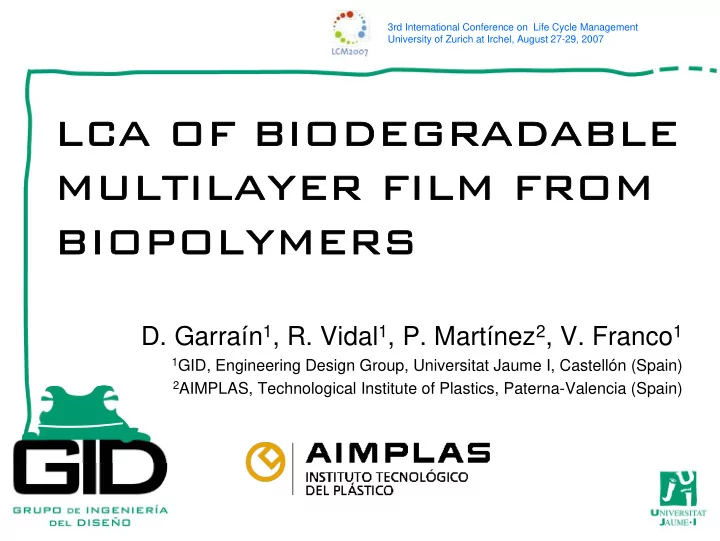

3rd International Conference on Life Cycle Management University of Zurich at Irchel, August 27-29, 2007 LCA OF BIODEGRADABLE LCA OF BIODEGRADABLE MULTILAYER FILM FROM MULTILAYER FILM FROM BIOPOLYMERS BIOPOLYMERS D. Garraín 1 , R. Vidal 1 , P. Martínez 2 , V. Franco 1 1 GID, Engineering Design Group, Universitat Jaume I, Castellón (Spain) 2 AIMPLAS, Technological Institute of Plastics, Paterna-Valencia (Spain)
index • Introduction • Goal, scope & functional unit • Life Cycle Inventory (LCI) • Biodegradable vs. conventional film • Disposal assessment • Conclusions SLIDE 2
introduction • Conventional plastics – Consumption of non-renewable resources – Impact upon waste disposal • Increasing interest in ‘green’ biodegradable materials SLIDE 3
introduction • Conventional film – Non biodegradable – Multiple layers • Outer layers: mechanical properties • Inner layers: gas barrier • New 100% biodegradable multilayer film – Used in food packaging – PLA-Starch-PLA SLIDE 4
Goal, scope & functional unit • Environmental impact assessment of biodegradable and conventional multilayer film – LCA methodology (EN-ISO 14040-14043) • Aspects that require further research from an environmental viewpoint SLIDE 5
Goal, scope & functional unit Life-Cycle Assessment Framework Goal and Scope Goal and Scope Definition Definition (ISO 14040) (IS 14040) Invent In ntory ory Interpretatio Int erpretation Analysi Analysis s (IS (ISO 14043) 14043) (IS (ISO 14041) 14041) Impact Impa ct Assessment Assessment (IS (ISO 14042) 14042) SLIDE 6
Goal, scope & functional unit • Functional unit:1 m 2 of packaging film – 25-200-50 for the biodegradable multilayer film (55% starch, 10% PCL and 32% PLA) – 130-20-130 for the conventional multilayer film (91% PP and 9% for PA6) SLIDE 7
Life cycle inventory (LCI) • Materials extraction – The inventory data used for PP and PA6 was provided by PlasticsEurope – The life cycle inventory data for PLA were extracted from Vink et al. (2003) – The environmental impacts of the different starches are obtained from the life cycle inventory by Dinkel et al. (1996) and Müller- Samann et al .(2003) – Others: PCL, lauroyl chloride, N 2 O emissions SLIDE 8
Life cycle inventory (LCI) • Film processing – Co-extrusion of the starch compound with dehumified PLA – Thermoforming to produce the packaging – Energy model used was obtained from the Union for the Co-ordination of Production and Transmission of Electricity (UCPTE) for Europe – Manufacturing of conventional and biodegradable film was tested at a pilot plant owned by AIMPLAS • Transport – Not considered unless it is very specialized (PLA, PCL) SLIDE 9
Biodegradable film vs. conventional film • Impact categories selection – Fossil energy depletion – Eutrophication – Acidification – Climate change SLIDE 10
Biodegradable film vs. conventional film • Fossil energy depletion SLIDE 11
Biodegradable film vs. conventional film • Eutrophication SLIDE 12
Biodegradable film vs. conventional film • Acidification SLIDE 13
Biodegradable film vs. conventional film • Global warming SLIDE 14
Disposal assessment • Focused on the global warming impact category (CO 2 , CH 4 ; Smith et al. 2001) • Three scenarios: – Incineration without energy recovery – Landfilling without gas control – Composting in simple windrow systems SLIDE 15
Disposal assessment • Incineration – The incineration of conventional plastics makes a net positive contribution to global warming (GWP=1) – The incineration of biobased materials as short-cycle carbon compounds is neutral in global warming terms (GWP=0) – Emissions of nitrous oxide from incinerators were estimated at 0.05 kg/t SLIDE 16
Disposal assessment • Landfilling – Anaerobic conditions – Landfill gas (50% methane and 50% carbon dioxide) – Carbon dioxide is assumed to be all short- cycle SLIDE 17
Disposal assessment • Composting – Composting is the aerobic degradation of waste to produce compost, which can be used as a soil improver – Substitution of other products • Plant growing media (e.g. peat) • Organic fertilizers (only in part) – Conventional film stays undegraded • Negative visual impact SLIDE 18
Disposal assessment • GHG emissions by composting scenario SLIDE 19
Conclusions • The production of multilayer film with petrochemical polymers exhibits a higher environmental impact than the production of biodegradable multilayer film – Global warming is the most significant impact category The performance of the Multibio multilayer film compares favourably to that of conventional multilayer film in this category – Eutrophication is the least significant impact category, so even though the Multibio multilayer film does not perform as well in this category, it still outperforms conventional film globally SLIDE 20
Conclusions • The environmental impact of biodegradable film is not unrelated to disposal methods – Biodegradable film has a better environmental performance when incinerated or composted (up to 90% improvement in GHG emissions) • The environmental impact of biodegradable plastics is likely to improve in the future SLIDE 21
Thank you! Thank you! garrain@uji.es SLIDE 22
Recommend
More recommend